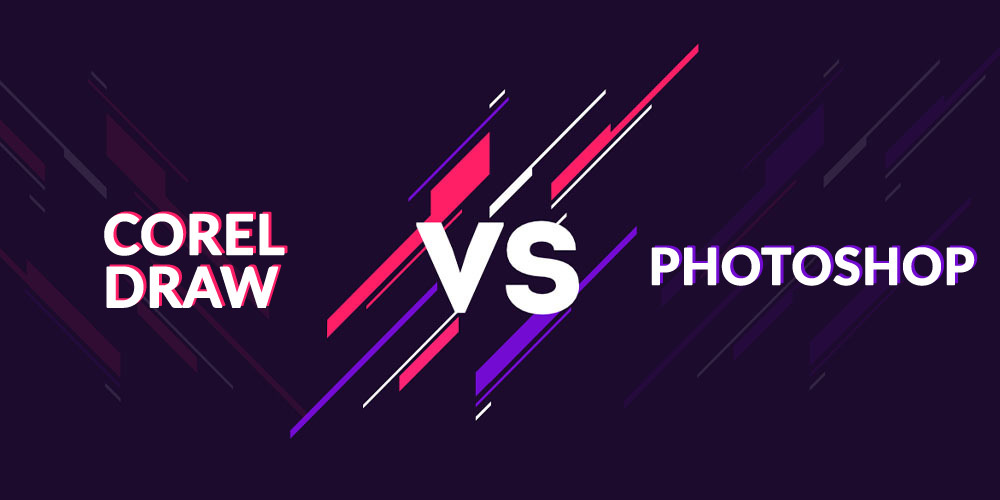
Adobe Photoshop and CorelDRAW are two of the most popular graphic design tools, yet they cater to different design needs and workflows. Understanding their similarities and differences can help users choose the right tool based on their specific requirements.
1. Purpose and Core Functionality
Adobe Photoshop is primarily a raster-based software designed for photo editing, image manipulation, and digital painting. It excels in pixel-perfect detail, making it ideal for tasks such as retouching photos, creating digital artwork, and designing web elements. CorelDRAW, on the other hand, is a vector-based graphic design program specializing in scalable vector graphics, making it perfect for logo design, illustration, and print layouts where resolution independence is key.
2. File Format and Scalability
One significant difference lies in file handling. Photoshop works with raster images that are resolution-dependent, meaning the quality degrades if the image is scaled beyond its original resolution. CorelDRAW operates with vector graphics, which remain crisp and clear at any size, making it better suited for large-format printing like billboards. Both applications support multiple file formats, but CorelDRAW is more focused on handling vector files like AI, SVG, and PDF.
3. User Interface and Ease of Use
The user interface of Photoshop is highly feature-rich, tailored for image editors and advanced users. It might feel overwhelming for beginners, though Adobe has introduced tools like the “Discover” panel to make it more approachable. CorelDRAW, while also powerful, offers a more intuitive interface for vector work, often praised for its ease of use, especially for users new to graphic design. It provides customizable toolbars and a more straightforward workflow for vector-based tasks.
4. Creative Tools
Photoshop is renowned for its advanced image editing capabilities, offering tools like layers, masks, blending modes, and a variety of brushes for digital painting. CorelDRAW focuses on precision tools for creating vectors, such as the Pen Tool, Shape Tool, and LiveSketch, which uses AI to convert freehand sketches into vector curves. While Photoshop does offer some vector capabilities, they are not as robust or flexible as CorelDRAW’s.
5. Collaboration and Integration
Photoshop integrates seamlessly with other Adobe Creative Cloud applications, such as Illustrator, InDesign, and Premiere Pro, allowing users to transfer assets and projects efficiently. CorelDRAW also offers integration with its suite, including Corel PHOTO-PAINT for image editing. However, Adobe’s ecosystem is more expansive and widely used in professional settings, providing an edge in collaborative workflows.
6. Output and Printing
For print media, CorelDRAW has a strong edge due to its vector foundation and advanced print preparation tools, including preflight features that ensure accurate color representation and alignment. Photoshop, while capable of producing print-ready designs, is more commonly used for digital media. That said, Photoshop’s color correction tools are indispensable in print projects that involve photographic elements.
7. Performance and Resource Demands
Photoshop is resource-intensive, particularly when handling large files with numerous layers. CorelDRAW is generally lighter on system resources, making it a better choice for users with less powerful hardware or those working on large-scale vector projects. However, both applications benefit from modern systems with sufficient RAM and powerful GPUs for smooth performance.
8. Pricing and Accessibility
Adobe Photoshop operates on a subscription-based model, which can be costly over time but includes regular updates and cloud storage. CorelDRAW offers both subscription and one-time purchase options, appealing to those who prefer to avoid recurring fees. While Photoshop is more dominant in professional industries, CorelDRAW is popular among small businesses and freelance designers for its affordability and versatile features.
In conclusion, both Adobe Photoshop and CorelDRAW have their strengths and weaknesses, depending on the task at hand. Photoshop excels in detailed raster-based work and integrates well into Adobe’s ecosystem, while CorelDRAW stands out for vector-based design and printing tasks, offering a user-friendly alternative for scalable graphics. The choice ultimately depends on the specific needs of the designer and the nature of the project.

